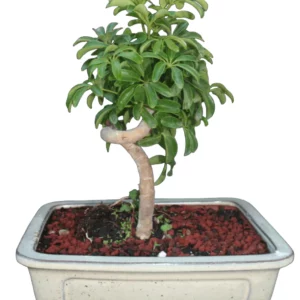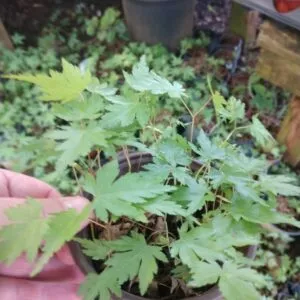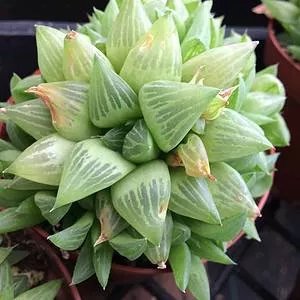No products in the cart.
Do you want to add some prehistoric drama to a tropical flair to your garden or home?
Then we have what you need the Sago Palm. Sago Palms is a great container plant and will add drama to any landscape.
Yet, it is not a true palm but is known as a Cycad, closely related to the pine family. The large green leaves fan out from the branch. So, are you interested in these palm trees?
Then keep reading to the end to find all the interesting facts and care for Sago Palm.
Plant Name: Cycas revoluta
Other Name: Sago Palm, King Sago Palm, Japanese Sago Palm
Plant Type: Perennial Shrub
Native Areas: Southern Japan
Light Requirement: Bright Indirect Light
Watering: Moderate
Fertilizer: Liquid Fertilizer
Toxicity: Toxic to Humans and Pets
Temperature: Down to 23°F
Propagation: Division
Growth: 3 to 10 feet tall
Soil Type: Sandy Soil With Good Drainage
USDA Hardiness Zones: 9-10
More About Sago Palm
As mentioned, Sago Palms are not true palm trees but cycads that are seed plants with some ancient roots belonging to cone-bearing conifers.
Some other famous names are King Sago, Japanese Funeral Palm, and Palm Cycad. The plants are native to Japan and use the leaves for funeral arrangements.
Another common species found is Queen Sago or Cycas circinallis, native to India and should not be confused with this plant.
Furthermore, the Sago should not be confused with Cycas micronesica, another species from Palau, Guam, and Micronesia.
The seeds of the latter are used as a food source, but they contain hazardous toxins and must not be consumed. Moreover, when eaten, it can cause liver failure and make you very sick.
These container plants can grow slowly with indoor gardening, making for an exceptional bonsai. When Sago Palm plants grow outside, they can reach maturity at 12 feet.
You see new growth sprouting from the top of the crown with a circular pattern found above the woody trunk.
The foliage is spiky and can be sharp, and you will find either female or male plants.
The male palm trees produce a 24-inch tall cone in late spring, while the female plant develops a leaf structure that looks like a basket with ovules.
The basket opens up when ready to fertilize with pollen and is carried by insects and the wind. Still, the Sago Palm can take up to ten years to mature and bloom.
Sago Palm Tree Care Guide
 sago palm @flickr
sago palm @flickr
Okay, so where do you plan to grow your Sago Palm? Yes, Sago Palm plants look fabulous in the landscape, but they are best grown indoors in certain parts of the country. The palm trees are extremely slow growing, so you will not need to trim them regularly.
It is a great plant grown outdoors and in your living space, and living fossils with a prehistoric attachment to it.
Soil For Sago Palm Plants
Growing Sago Palm is relatively low maintenance as these are slow-growing plants that are drought tolerant to some extent and not fussy about their soil.
The important thing is to provide Sago Palms with well-draining soil. Then, plant your palm in a potting mixture with the sand and add organic matter.
The palm trees prefer potting soil that is slightly neutral to acidic. So, choose potting soil made for a cactus plant for container plants.
Lighting Needs For Palm Trees
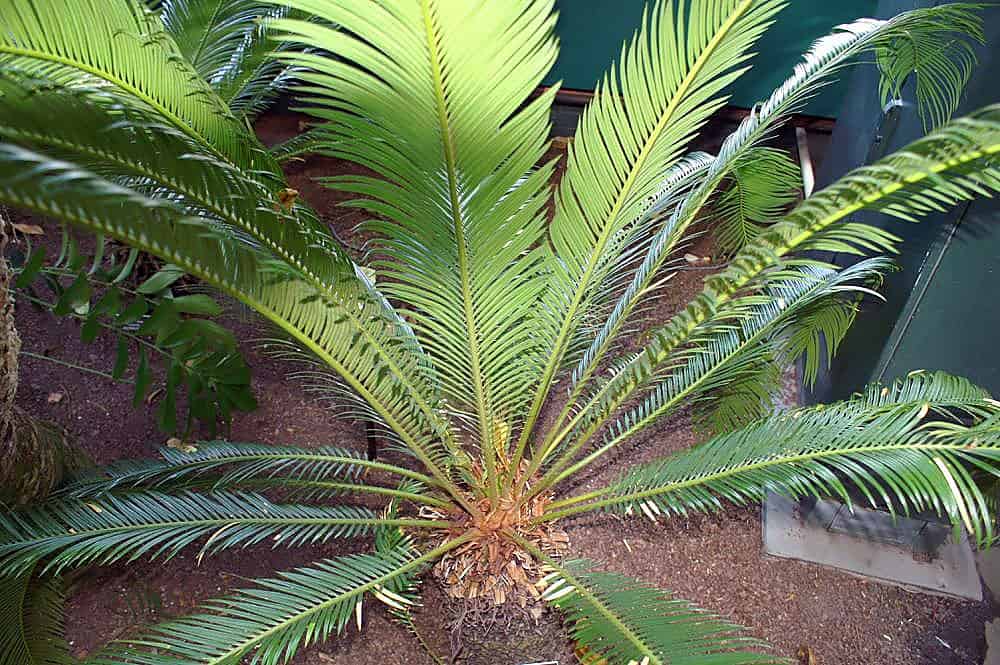
In the real world, sago plants are mostly grown outdoors. You can bring them indoors and place them near a sunny windowsill for a perfect spot. Sago palm plants thrive best in bright, indirect light. But provide them with some partial shade and not in direct sunlight. The afternoon sun will scorch the leaves during summertime.
Too much shade will result in less foliage making your plant look unhealthy. When container plants stand indoors, it helps to choose a bright dappled light spot. You can move your plants outside when the weather warms up, but keep them in dappled light.
Watering King Sago Palm
Sago palms are drought tolerant but still prefer to remain moist. So keep checking the potting mixture to ensure the soil remains moist. Another concern is not to allow the root ball to sit in water as it can lead to plant death resulting from root rot.
So, wet feet are a huge no-no for the Sago Palm. Ensure sufficient drainage allows excess water to run away from the root system. You may find in hot climates, you need to water more than in another temperate zone.
Temperature and Humidity

Sago palm tree loves warm climates with humidity. Your palm tree can take cold temperatures, but frost will damage the fronds, especially if it goes below 23°F.
Protect your sago palm from airflow from air-conditioners and heating systems for indoor growing. With extreme temperature fluctuations, the foliage becomes damaged.
Cold temperatures are not ideal for sago palms since these are tropical plants. If you’re living in a colder area, the is best grown indoors and a perfect plant to grow in growing zone 9 to 10 outdoors but grown as a houseplant in all the other zones.
-
Free Shipping$87.14Sold By: BONSAI WORLD LLC
Only 1 left in stock
Large Coiled Umbrella Bonsai Tree
Sold By: BONSAI WORLD LLC -
$20.24 – $45.35Sold By: Carlo's Plant Farm
In stock
SUMMER SUNSET JASMINE – LIVE STARTER PLANTS LESS THAN 12 INCHES TALL
Rated 5.00 out of 5 based on 22 customer ratings00Sold By: Carlo's Plant Farm -
$18.95Sold By: Willows Bonsai
In stock
4 inch Green Japanese Maple Pre Bonsai, trees grown by me
Sold By: Willows Bonsai -
$10.00Sold By: Smoot's Farm
In stock
Lilium Asiatic Lily Cogoleto Pink Flower 3 bulbs per order Size 1
Rated 4.89 out of 5 based on 27 customer ratings00Sold By: Smoot's Farm
Fertilizing Care For Sago Palm
Your Cycas revoluta can grow well without any added feeds. But if you want them to produce flowers, give them some slow-release fertilizer. For container plants, they can do regular feeding during the growing season.
The Sago Palm needs more magnesium and micronutrients compared to other plants. With thinking of slow growth, the same applies to the feeds you use. Hence, using a slow-release fertilizer with a 12-4-12-4 ratio is best.
The balance of the micronutrients present will help with nutrient deficiency to prevent the leaf from turning yellow. You can administer the feed every three months to ensure the leaf will turn green.
Pruning Sago Palm Growing Indoors and Outside
 sago palm @flickr
sago palm @flickr
You only need to prune your Sago Palm when the leaves turn brown. Yet, we recommend keeping the yellow leaves as they still absorb nutrients for your plant.
When removing the leaves, turning yellow might worsen the problem. For removing fronds, we recommend cutting away the ones at the bottom of the plant with sterilized pruning shears.
Removing the old brown leaves will allow new fronds to emerge from the symmetrical ring.
Potting Your Sago Palm Plant
As your palm trees grow slowly, you will not need to repot often, and it should take about three years before repotting. Then, you can gently remove your plant from the pot in spring to replace the potting mix with fresh soil.
We recommend you amend the soil with some sand and peat moss. For your newly planted palm trees, you can move them during early spring, but for mature palms, you can transplant them in early spring or the late fall.
The best container is an unglazed ceramic or terra cotta with adequate drainage to prevent soggy soil.
Propagation of Sago Palms
You can propagate sago palms through seeds or division.
DIVISION OF SAGO PALM PLANTS
For division, you will notice new growth forming near the base of the parent plant called pups, and best to remove them before they are a foot tall.
Clear the dirt around the base in spring or fall around each pup.
Grasp the pup base gently to pop off. Cut the pups off with a sterilized knife if they grow too large.
Remove any leaves sprouting from the pups and place them in the shade for a week allowing the wound to heal.
Take a couple of containers larger in diameter than the offset.
Fill the pot with sand, peat moss, and perlite. Dig a hole and place your offset in the hole with the cut section down.
Keep the soil moist, and when the soil dries, water again. Place in shade away from direct sunlight until rooted.
PLANTING SEED
To plant seeds, you will need a female Sago Palm to harvest in the fall when the seeds are ripe. Then, with gloves, collect the orange fruit and place them in a bucket of water.
Keep the seeds that sink to the bottom. You can store the seeds in an airtight container at room temperature. Before planting, soak the seed in water overnight as it helps soften the outer layer and rinse well before placing it in a container with soil.
Also, plant the seed with the flat side up and keep 1/3 of the seed above the soil line. Place the container in a warm spot.
Sago Palm Varieties
You can find varieties of Sago Palms to grow as container plants or in the garden.
King Sago Palm
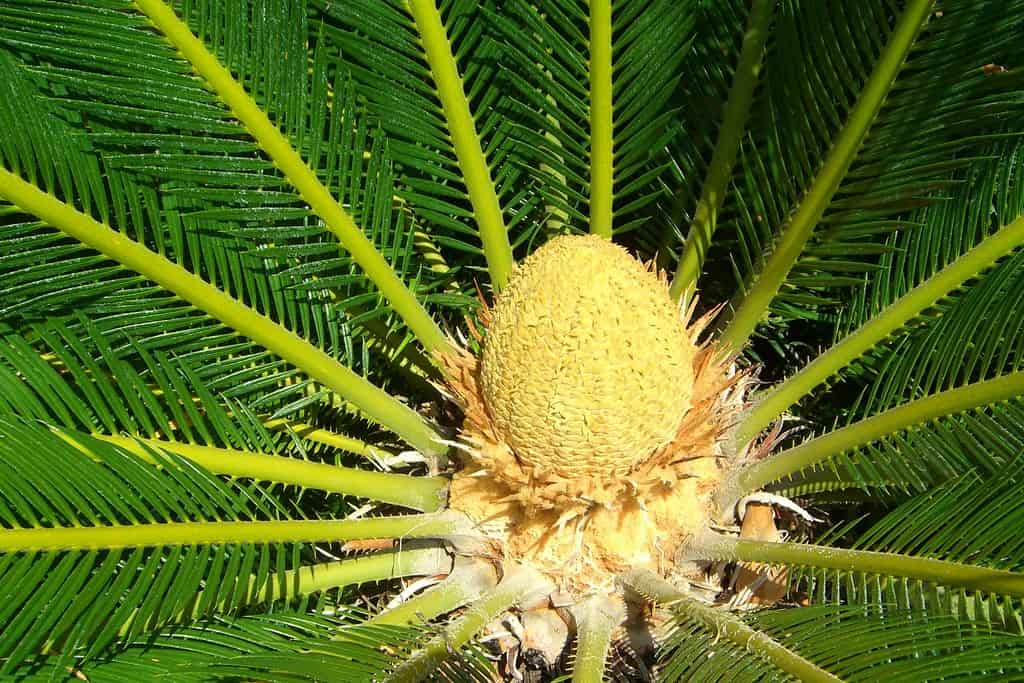 king sago palm @flickr
king sago palm @flickr
It is a popular variety and the one we discussed today, the Cycas revoluta. It is native to Japan and has a short trunk with symmetrical green leaves.
QueenSago Palm

The Crycas rumphii comes from southeast Asia and grows more like a tree than your typical shrub.
The True Sago Palm

Metoxylon sagu is the real palm and belongs to the Arecaceae family, native to southeastern Asia, adding a tropical flair to the garden. These palm trees can reach up to 80 feet tall.
Sago Palm Common Diseases and Pests
The Sago Palm is a hardy plant, but you can find some potential pest problems. These include leaves that turn yellow, sooty mold, and scale bugs. It helps to use neem oil and organic insecticidal soap on your palm trees to control the scale bugs to other insects.
Frequently Asked Questions
The plant is mostly used as an ornamental plant in landscaping or home.
Sago Palms can live up to 200 years when grown in bright light with well-draining soil and occasional pruning.
The best way to remove a pup is to grasp it with the hand around the base to pop them off.
Sago Palms are poisonous to humans and pets from the foliage to the roots. When ingested, it can cause liver failure and make you very sick.
The good news is that you can find the Sago Palm at a local garden center or here with us at Plantly. The best part is you need not leave your home and can have your palm tree delivered to your door.
Whether you want to buy, sell, or simply reach out to other plant enthusiasts, Plantly is the right place to be!
-
$15.95Sold By: SunSoul Plants
$18.95In stock
Sansevieria laurentii snake plant | 4 inch pot
Rated 4.87 out of 5 based on 98 customer ratings00Sold By: SunSoul Plants -
$11.99Sold By: Succulent Oasis
Only 1 left in stock
Medium Montrose ‘Mini’. A cluster of small, rounded stems.
Rated 4.84 out of 5 based on 352 customer ratings02Sold By: Succulent Oasis -
$69.99Sold By: Succulent Oasis
In stock
Large Sago Palm
Rated 4.84 out of 5 based on 352 customer ratings00Sold By: Succulent Oasis -
$9.99Sold By: Succulent Oasis
In stock
Medium Succulent Plant – Haworthia Cooperi var Truncata. Beautiful, glassy appearing succulent.
Only 10 available and it’s in 1 people’s basketRated 4.84 out of 5 based on 352 customer ratings01Sold By: Succulent Oasis
